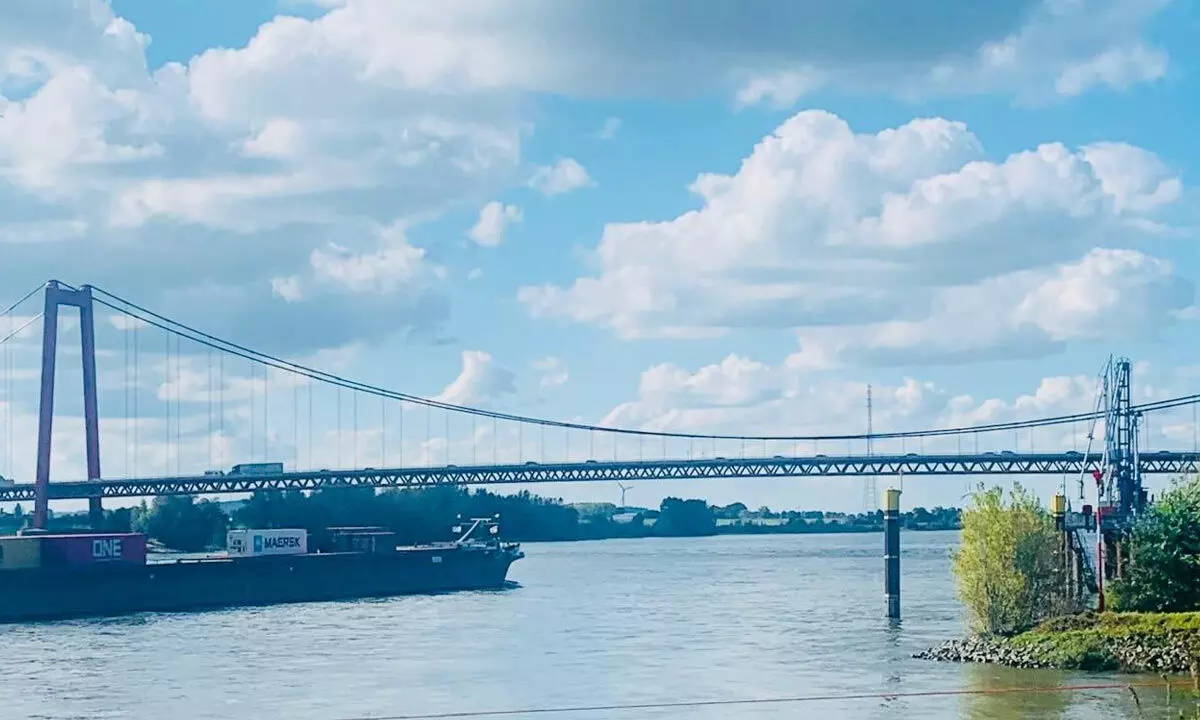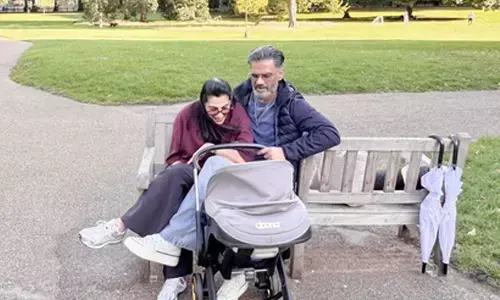Learning from Rhine River Purification

With just four days left for our departure from Amstelveen (Amsterdam) to Hyderabad, after eight weeks of stay at my son Aditya’s house, four of our family members decided to go on a short visit to ‘Emmerich’ in Germany, located near the German-Dutch border, and nearby ‘Hochelten.’
With just four days left for our departure from Amstelveen (Amsterdam) to Hyderabad, after eight weeks of stay at my son Aditya’s house, four of our family members decided to go on a short visit to ‘Emmerich’ in Germany, located near the German-Dutch border, and nearby ‘Hochelten.’ We started in the morning and returned the same day. Emmerich is called as ‘Emmerich am Rhein’ indicating the town's location on the banks of the ‘Rhine River.’ Emmerich is a German name and derives from old Germanic roots, and ‘am Rhein’ literally means ‘On the River Rhine.’ It indicates that, the town is located on the banks of the Rhine River.
En route, we had a bird’s eye view of a few charming towns and cities, natural reserves, historic sites, natural beauty, and cultural highlights. They included among others: Abcoude, a small picturesque village; Utrecht, one of the Netherlands' oldest cities; Arnhem City famous during World War II; a large national park (De Hoge Veluwe); Nijmegen, the oldest city of Roman times in Netherlands; Groesbeek village bordering Germany which is known for its wine and World War II history etc.
Since Netherlands and Germany are part of the Schengen Area, travelling from Amsterdam to Emmerich with a valid Schengen visa did not require for us to go through regular visa checks when crossing the border between the two countries. However, we were cautioned by some friends in Amsterdam before our visit to carry our valid visa passports, in case of any spot or random checks. We did not come across any such check.
We reached Emmerich in the next two hours, despite an unusual heavy traffic. And once we are in Emmerich, before exploring the places to visit in the shortest time that was at our disposal, we had our ‘German Cuisine Breakfast’ on the way to St Vitus Church (St Vitus Kirche). The Church is located in Emmerich’s neighborhood of ‘Hochelten’ a historic part of the town that is situated on a hill providing scenic views of the surrounding area.
St Vitus Church, a significant landmark in Hochelten, and an important religious site for the Catholic Community, has a long history dating back to medieval times. Originally built around the 9th century, it was rebuilt after damage during World War II, with the architectural style of ‘Romanesque’ with later ‘Gothic Elements’ giving it a blend of historical and artistic significance. The Tower of the Church is a prominent feature and can be seen from a long distance. The surrounding area of Hochelten is a picturesque one. The hill on which the Church is located offers panoramic views of the ‘Rhine River’ and Dutch Border.
‘Hochelten’ is a small district near Emmerich, and the area around it has been inhabited for centuries. When we dropped in the ‘Tourist Information Center’ a little away from St Vitus Church, the Old Lady sitting there briefed us about the place. Archaeological findings suggest that it was settled as early as the Stone Age. Its strategic location near the ‘Rhine River’ made it a desirable place, and became more established during the Middle Ages. ‘Hochelten’ has been derived from ‘Old High German’ (High Land or Hill) referring to its elevation above the surrounding areas.
The community was part of the medieval structure of small villages that dotted the Rhine Region. Hochelten was incorporated into the town of Emmerich in the 19th century. This integration contributed to the growth and development of the area as part of a larger urban framework. However, the community retained its rural charm while benefiting from the amenities of a growing town. Today, Hochelten is known for its picturesque landscapes, historic buildings, and community spirit. It retains a blend of historical architecture and modern living. The district is also appreciated for its scenic views of the Rhine River, attracting residents and visitors.
In fact, after World War II, many areas in Germany, including Emmerich and its districts like Hochelten, experienced extensive damage due to bombing and military actions. The post-war period focused on reconstruction and urban planning. Hochelten, benefiting from its historical architecture, was part of efforts to restore and preserve its cultural heritage while modernizing infrastructure. The post-war years saw a significant increase in population as people migrated from rural areas to towns for better economic opportunities. Hochelten, being part of Emmerich, attracted new residents looking for housing and jobs.
Hochelten's location near the Netherlands facilitated cross-border interactions, fostering relationships between communities on both sides of the Rhine River. Post-World War II, Hochelten transformed from a historically significant district into a vibrant community focused on reconstruction, economic development, and cultural preservation. Its evolution during this time reflected broader trends in Germany, emphasizing recovery, integration, and community identity. The district remains an important part of Emmerich's cultural landscape, embodying the resilience and adaptability of its residents.
From there we moved to the nearby ‘Emmerich Rhine Bridge’ on the Rhine River, which is part of ‘Emmerich am Rhein’ and is situated closer to the town center. This bridge is the ‘Longest Suspension Bridge in Germany’ spanning about 803 meters, and was opened in 1965. The Rhine River is a major European waterway, flowing through several countries, including Germany. In Emmerich, it offers picturesque views with pathways along the riverbank that are perfect for walking and cycling.
In the 1980s, the Rhine was severely polluted, primarily from industrial waste. Countries along the Rhine (Switzerland, Germany, and the Netherlands) collaborated through the ‘International Commission for the Protection of the Rhine (ICPR)’ to implement pollution control, wastewater treatment plants, and industrial discharge regulations. The river's water quality has significantly improved, making it a source of drinking water for millions of people.
The cleanup fostered strong international cooperation among River Rhine-Bordering countries, demonstrating the benefits of multilateral environmental governance. Now the River supports tourism, transportation, and economic activities like fishing and agriculture along its banks. If the proposed ‘Musi River Purification and Restoration Project’ in Hyderabad, conceived by Chief Minister A Revanth Reddy, emulates, and learns some lessons from the ‘Rhine River Purification Process’ probably it may sound better, and may yield desired results.
Though Rhine Bridge is not directly in Hochelten, it is nearby, and just a short drive away. ‘Emmerich am Rhein’ and the ‘Hochelten Area’ are indeed geographically close but distinct. The Bridge also connects ‘Emmerich am Rhein’ with ‘Kleve’ a town in the Lower Rhine region of Northwestern Germany near the Dutch Border and the River Rhine. The bridge besides providing stunning views of the Rhine River, is great spot for photography or a leisurely walk.
Along the riverside walkway, a number of restaurants, with seating arrangements made open to the sky, facing the river view for relaxation, offer a mix of local and international cuisine. After exploring the historic St Vitus Church, ‘Hochelten’ and Rhine Bridge, we randomly chose ‘Restaurant Hof Von Holland’ and sitting under the bright sunshine, enjoyed sipping distinctive German Beers the ‘Krombacher Pils’ and ‘Krombacher Weizen.’ The first one, a ‘Genuine Premium Pilsner Beer’ was a characteristic, finely bitter tasted and a full-flavored aroma. The second one is a ‘Well-Loved Wheat Beer’ with typical German fruity, slightly spicy flavor Wheat Beers, from the nearby North Rhine-Westphalia Region in Western German State.
Though there are a couple of other places of tourist interest to visit like ‘Emmerich Town Hall building, Klever Gate, St Martin's Church, PAN Art Forum’ (A modern art museum and cultural center) etc. we were not able to see them for paucity of time. Nevertheless, we perfectly enjoyed visit to St Vitus Church, the Rhine Suspension Bridge, and stunning Rhine River views, not to speak of a relaxing meal over German Beer, that made the experience both enriching and memorable.














